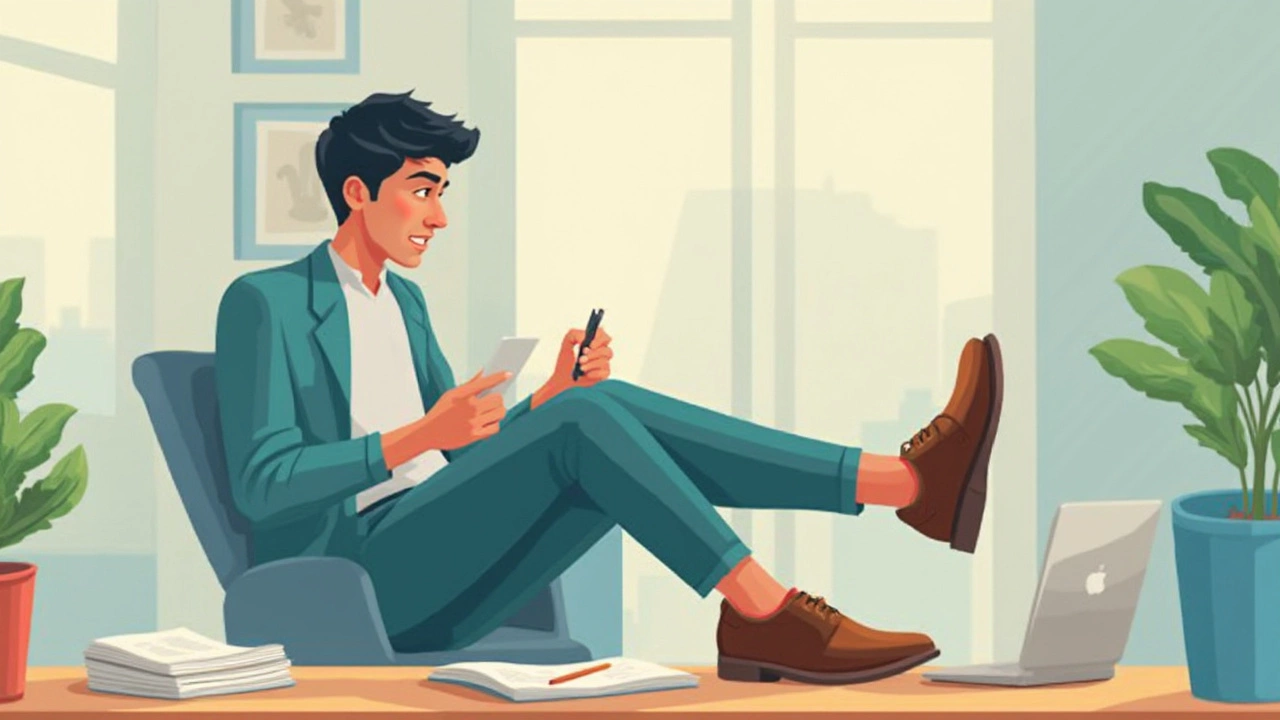Ever wondered why your trusted podiatrist flinches a little when you mention wearing Skechers for work? It’s not just you; it’s a common conversation in clinics. While Skechers are hailed for their comfy and trendy styles, they might not be the knight in shining armor for your feet, especially during long work hours. Intrigued? Read on.
So, what's the deal? Well, let’s start with comfort. People love Skechers for their plush, cushy feel. But here’s the kicker—comfort doesn’t always equal support. If you’re spending countless hours standing or walking at work, arch support and stability in shoes become your BFFs. Sadly, Skechers often fall short in this department, leaving your feet in a precarious position.
- Comfort vs. Support in Skechers
- Durability Concerns
- The Right Work Shoe Features
- Podiatrists' Recommendations
Comfort vs. Support in Skechers
Skechers have found their way into many closets because they feel great to slip into. They often use memory foam, which molds to your feet just like your favorite pillow does for your head. Sounds heavenly, right? But hang on—this isn't always the best for your foot’s health, especially when it comes to work shoes.
Here's the catch: memory foam provides immediate cushioning but doesn’t necessarily offer the needed arch support. Imagine your foot as a bridge—it needs the support of good arches to remain steady and prevent strain. Skechers might make you feel like you’re walking on clouds, but without proper support, over time, you might start feeling pain in your heels, arches, or even your lower back.
Now, why does this matter for podiatrists? These foot doctors see the aftermath: bunions, plantar fasciitis, and other painful conditions that often arise when shoes lack support. While Skechers excel in comfort, they can falter in keeping your feet aligned properly. That’s why your podiatrists might give you a side-eye when you mention using them for long work hours.
The Casual vs. Work Shoe Conundrum
Skechers design shoes mainly for casual wear, so if you're picking them for occasions where you’re mostly sitting or doing light activities, they’re more than fine. However, when your day involves lots of standing, walking, or carrying weights—typical in workplaces—strategically designed work shoes take precedence.
- Check for shoes with built-in arch support.
- Look for firm soles that don’t bend easily under pressure.
- Avoid shoes with just memory foam insoles—opt for those with structural support.
While Skechers are trendy and comfortable, assessing their suitability for work is a different ball game. Always weigh the pros of comfort against the cons of limited support, and you’ll quickly see why podiatrists might steer you elsewhere for work shoes.
Durability Concerns
When it comes to work shoes, longevity is key. Nobody wants to keep replacing them every few months, especially when you're relying on them daily to support you on the job. Here’s where the conversation about Skechers can take a turn.
Many Skechers fans notice that these shoes often wear out faster than more robust options. The materials used in crafting most Skechers models, particularly those made for casual settings, tend to prioritize comfort and style over long-term durability. That’s great for a weekend outing but possibly problematic for a demanding work environment. So, why does this matter?
Material Matters
Skechers typically use lightweight materials. While they make the shoes easier to wear, they’re not always up to scratch for the wear and tear experienced in active work conditions. These materials can lead to the soles wearing thin and the uppers developing tears relatively quickly.
Cost Implications
Replacing work shoes every few months can be a costly affair. Although Skechers might initially seem like a budget-friendly choice, frequent replacements—not to mention potential medical costs if you develop foot problems—can quickly add up.
Work Environment
Consider the specific demands of your job. Are you moving around a lot? Walking on rough surfaces? Or maybe dealing with spills and slick floors? In these scenarios, you'd want something that's specifically built to withstand such conditions.
Reliable work shoes often include features like reinforced toe caps, slip-resistant soles, and tough, high-quality materials. These are not always highlighted in Skechers models aimed at casual users, leading to faster degradation in a work setting.
If you're all about making sure your feet—and wallet—are in good shape, it might be time to explore alternatives that last longer and truly fit the working environment.

The Right Work Shoe Features
Picking the perfect work shoe isn’t just about the look; it’s about keeping your feet happy day in and day out. So, what should you look for? Here’s the lowdown on the features that matter most.
Support and Stability
If you're on your feet all day, support is king. Look for shoes with good arch support. This is crucial for preventing foot fatigue and conditions like plantar fasciitis. Also, ensure the shoes offer adequate lateral stability to prevent rolling your ankles when moving around.
Durability Matters
Investing in durable shoes is a money saver in the long run. Materials matter here; go for leather or hard-wearing synthetics that can take the daily grind. A hefty price tag might sting upfront, but your feet—and wallet—will thank you when you’re not replacing shoes every few months.
Comfort is Key
Don't just rely on how comfy a shoe feels initially. Look for cushioning that adapts to your foot's shape. Features like memory foam can sometimes lose their plush feeling too soon, so consider well-padded insoles that maintain their bounce over time.
Check the Traction
Good traction is a must, especially if you're working in slippery environments. Non-slip soles are your go-to to keep you upright and accident-free.
- Arch Support: Look for shoes that have built-in arch support.
- Material Quality: Durable materials like leather are preferred.
- Cushioning: Ensure cushioning withstands long-term use.
- Traction: Opt for non-slip soles for safety.
Extra Tips
When trying on shoes, do it in the evening when your feet are at their largest. Break them in at home before committing to a full workday to ensure they don’t cause any issues. And, don’t forget to replace your work shoes regularly, as even the best pairs wear out eventually.
Podiatrists' Recommendations
If you're standing all day, you need footwear that has your back—or rather, your feet. Here’s what a podiatrist might tell you when you're picking out work shoes.
1. Prioritize Arch Support
Your arches like a bit of support to keep things balanced. Shoes with solid arch support help prevent pain and encourage better posture. It's something much needed if Skechers are not providing what your job demands.
2. Look for Stability
Skipping across a slippery floor? You better have stability on your side. Podiatrists recommend shoes that reduce wobble, keeping your feet grounded and steady. Consider work shoes with a firm heel counter—it's a game-changer!
3. Durable Cushioning
Comfort is precious, but it shouldn’t come at the expense of durability. Solid cushioning that keeps its shape over time is key. While Skechers might start off cushioning well, podiatrists worry about how they hold up through the long haul.
4. Snug Fit
Loafers are meant to slip on, not slip off! Make sure your work shoes fit snugly, avoiding any unnecessary friction. A good fit offers control and reduces the risk of blisters.
5. Material Matters
Breathe easy! Shoes made from breathable material can prevent those nasty foot odors and keep infections at bay. Genuine leather or mesh fabrics are usually a win.
- Durability Concerns: Solid construction matters when you’re clocking miles at work.
- Foot Health: Keeping things airy and supportive for healthier feet.
While Skechers might shine as casual wear, when it comes to long hours on the job, considering these expert tips helps you step up your shoe game wisely.

